
HMS Fiji was the lead ship of the Fiji-class light cruisers built for the Royal Navy shortly before the Second World War. Completed in mid-1940, she was initially assigned to the Home Fleet and was detached to escort a force tasked to force French West Africa to join the Free French. The ship was torpedoed en route and required six months to be repaired. Fiji was then assigned to Force H where she helped to escort convoys to Malta. The ship was transferred to the Mediterranean Fleet in early May 1941. After the Germans invaded Crete a few weeks later, she was sunk by German aircraft on 22 May after having fired off all of her anti-aircraft ammunition.

The Nevada class comprised two dreadnought battleships—Nevada and Oklahoma—built for the United States Navy in the 1910s. They were significant developments in battleship design, being the first in the world to adopt "all or nothing" armor, a major step forward in armor protection because it emphasized protection optimized for long-range engagements before the Battle of Jutland demonstrated the need for such a layout. They also introduced three-gun turrets and oil-fired water-tube boilers to the US fleet. The two Nevadas were the progenitors of the standard-type battleship, a group that included the next four classes of broadly similar battleships that were intended to be tactically homogeneous.

The King George V-class battleships were the most modern British battleships in commission during World War II. Five ships of this class were built: HMS King George V, HMS Prince of Wales (1941), HMS Duke of York (1941), HMS Anson (1942) and HMS Howe (1942).
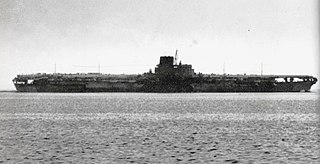
Shinano (信濃) was an aircraft carrier built by the Imperial Japanese Navy (IJN) during World War II, the largest such built up to that time. Laid down in May 1940 as the third of the Yamato-class battleships, Shinano's partially complete hull was ordered to be converted to an aircraft carrier following Japan's disastrous loss of four of her original six fleet carriers at the Battle of Midway in mid-1942. The advanced state of her construction prevented her conversion into a fleet carrier, so the IJN decided to convert her into a carrier that supported other carriers.
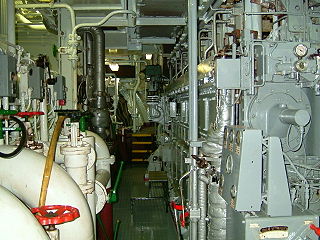
On a ship, the engine room (ER) is the compartment where the machinery for marine propulsion is located. To increase a vessel's safety and chances of surviving damage, the machinery necessary for the ship's operation may be segregated into various spaces. The engine room is generally the largest physical compartment of the machinery space. It houses the vessel's prime mover, usually some variations of a heat engine. On some ships, there may be more than one engine room, such as forward and aft, or port or starboard engine rooms, or may be simply numbered.
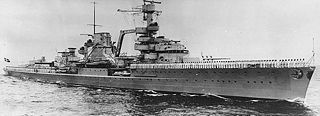
Leipzig was the lead ship of her class of light cruisers built by the German navy. She had one sister ship, Nürnberg. Leipzig was laid down in April 1928, was launched in October 1929, and was commissioned into the Reichsmarine in October 1931. Armed with a main battery of nine 15 cm (5.9 in) guns in three triple turrets, Leipzig had a top speed of 32 knots.
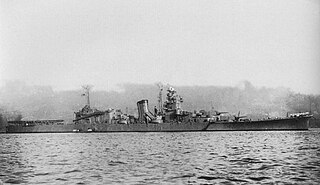
Ōyodo (大淀) was a light cruiser built for the Imperial Japanese Navy (IJN) during World War II, and was the only ship of her class completed before the end of the war. Designed to command submarine operations, she was obsolete upon completion in 1943. The ship was used as a transport and to escort the navy's capital ships for the rest of the year. Ōyodo was lightly damaged by American aircraft in early January 1944 during one transport mission and returned home several months later to begin conversion to serve as the flagship of the Combined Fleet.

The Richelieu class were fast battleships built for the French Navy between the 1930s and 1950s. Initially two ships were ordered in 1935 in response to Italian orders for the Littorio-class battleships the previous year. The Richelieus were based on the preceding Dunkerque class, but scaled up to accommodate more powerful 380 mm (15 in) guns and armor to protect them from guns of the same caliber. To keep the ships within the displacement limits imposed by the Washington Naval Treaty, they featured the same concentrated arrangement as the Dunkerques for the main battery: two quadruple gun turrets placed forward. They also incorporated new, more compact boilers that allowed for a shorter hull for the desired top speed. After Germany ordered two Bismarck-class battleships, France responded with another pair of Richelieus, but built to modified designs. The first, Clemenceau, received modified secondary and anti-aircraft batteries, while Gascogne had her superfiring main battery turret shifted aft, along with other changes.

The Normandie class consisted of five dreadnought battleships ordered for the French Navy in 1912–1913. It comprised Normandie, the lead ship, Flandre, Gascogne, Languedoc, and Béarn. The design incorporated a radical arrangement for the twelve 340 mm (13.4 in) main battery guns: three quadruple-gun turrets, the first of their kind, as opposed to the twin-gun turrets used by most other navies. The first four ships were also equipped with an unusual hybrid propulsion system that used both steam turbines and triple-expansion steam engines to increase fuel efficiency.

The Russian battleship Sevastopol was the first ship completed of the Gangut-class battleships of the Imperial Russian Navy, built before World War I. The Ganguts were the first class of Russian dreadnoughts. She was named after the Siege of Sevastopol during the Crimean War. She was completed during the winter of 1914–1915, but was not ready for combat until mid-1915. Her role was to defend the mouth of the Gulf of Finland against the Germans, who never tried to enter, so she spent her time training and providing cover for minelaying operations. Her crew joined the general mutiny of the Baltic Fleet after the February Revolution and joined the Bolsheviks later that year. She was laid up in 1918 for lack of manpower, but her crew joined the Kronstadt Rebellion of 1921. She was renamed Parizhskaya Kommuna after the rebellion was crushed to commemorate the Paris Commune and to erase the ship's 'betrayal' of the Communist Party.

Slava was a pre-dreadnought battleship of the Imperial Russian Navy, the last of the five Borodino-class battleships. Completed too late to participate in the Battle of Tsushima during the Russo-Japanese War, she survived while all of her sister ships were either sunk during the battle or surrendered to the Imperial Japanese Navy.
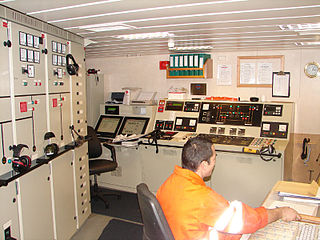
An engine officer, also called an engineering officer or simply engineer, is a licensed mariner qualified and responsible for operating and maintaining the propulsion plants and support systems for a watercraft and its crew, passengers and cargo. Engine officers are usually educated and qualified as engineering technicians.
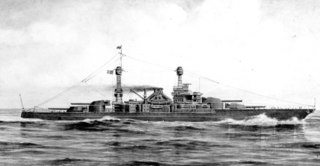
The first South Dakota class was a group of six battleships that were laid down in 1920 for the U.S. Navy, but were never completed. They would have been the largest, most heavily armed and armored battleships in the world and, designed to achieve 23 knots, represented an attempt to catch up with the increasing fleet speeds of its main rivals, the British Royal Navy and Imperial Japanese Navy.

The O class was a planned class of three battlecruisers for the Kriegsmarine before World War II. Prompted by a perceived lack in ship numbers when compared with the British Royal Navy, the O class' design was born with the suggestion of modifying the P-class cruiser design with 380 mm (15 in) guns instead of 283 mm (11.1 in).

The three Chester-class cruisers were the first United States Navy vessels to be designed and designated as fast "scout cruisers" for fleet reconnaissance. They had high speed but little armor or armament. They were authorized in January 1904, ordered in fiscal year 1905, and completed in 1908. In 1920 all scout cruisers were redesignated as "light cruisers" (CL).

The Nassau class was a group of four German dreadnought battleships built for the German Kaiserliche Marine in the mid-1900s. The class comprised Nassau, the lead ship, Rheinland, Posen, and Westfalen. All four ships were laid down in mid-1907, and completed by late 1910. Though commonly perceived as having been built in response to the British Dreadnought, their design traces its origin to 1903; they were in fact a response to Dreadnought's predecessors of the Lord Nelson class. The Nassaus adopted a main battery of twelve 28 cm (11 in) guns in six twin-gun turrets in an unusual hexagonal arrangement. Unlike many other dreadnoughts, the Nassau-class ships retained triple-expansion steam engines instead of more powerful steam turbines.
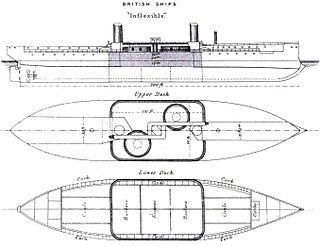
All or nothing is a method of naval warship armour, best known for its employment on dreadnought battleships. The concept involves heavily armoring the areas most important to a ship while the rest of the ship receives significantly less armor. The "all or nothing" concept avoided light or moderate thicknesses of armor: armor was used in the greatest practicable thickness or not at all, thereby providing "either total or negligible protection". Compared to previous armoring systems, "all or nothing" ships had thicker armor covering a smaller proportion of the hull. The ironclad battleship HMS Inflexible launched in 1876 had featured a heavily armored central citadel, with relatively unarmored ends; however, by the era of HMS Dreadnought, battleships were armored over the length of the ship with varying zones of heavy, moderate or light armor. The U.S. Navy adopted what was formally called "all or nothing" armor in the Standard-type battleships, starting with the Nevada class laid down in 1912. The Imperial Japanese Navy soon implemented the system in its Nagato-class battleships starting in 1917, and "All or Nothing" armor was later adopted by other navies after the First World War, beginning with the Royal Navy in its Nelson class.

The Comandanti Medaglie d'Oro class were a group of 20 destroyers ordered for the Regia Marina during World War II. Nine had been laid down by the time of the Italian armistice in September 1943 and all but one of those ships which had not yet been laid down were cancelled. Of those that had been laid down, none had been launched by that time and all were subsequently scrapped.

Jurien de la Gravière was a protected cruiser built for the French Navy in the late 1890s and early 1900s, the last vessel of that type built in France. Intended to serve overseas in the French colonial empire, the ship was ordered during a period of internal conflict between proponents of different types of cruisers. She was given a high top speed to enable her to operate as a commerce raider, but the required hull shape made her maneuver poorly. The ship also suffered from problems with her propulsion machinery that kept her from reaching her intended top speed. She carried a main battery of eight 164 mm (6.5 in) guns and was protected by a curved armor deck that was 35–65 mm (1.4–2.6 in) thick.

On a ship, the fire room, or FR or boiler room or stokehold, referred to the space, or spaces, of a vessel where water was brought to a boil. The steam was then transmitted to a separate engine room, often located immediately aft, where it was utilized to power the vessel. To increase the safety and damage survivability of a vessel, the machinery necessary for operations may be segregated into various spaces, the fire room was one of these spaces, and was among the largest physical compartment of the machinery space. On some ships, the space comprised more than one fire room, such as forward and aft, or port or starboard fire rooms, or may be simply numbered. Each room was connected to a flue, exhausting into a stack ventilating smoke.